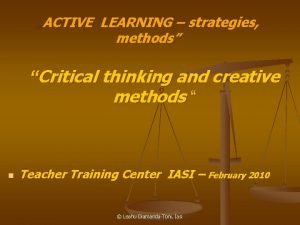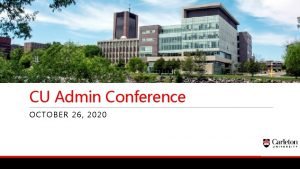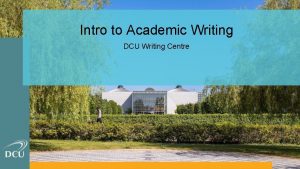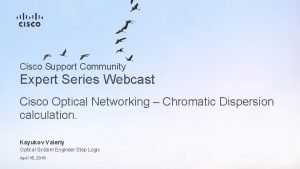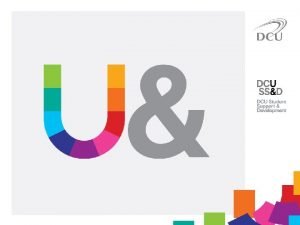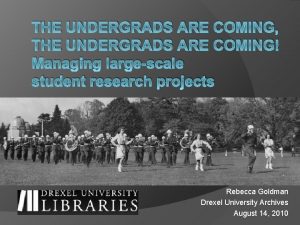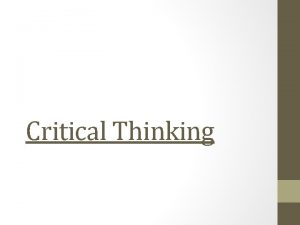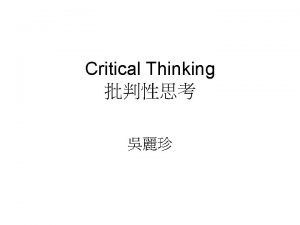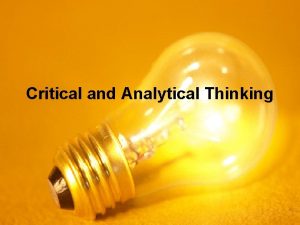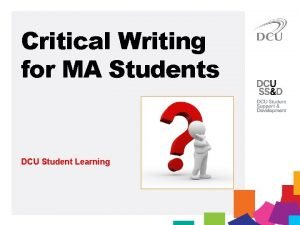Critical Thinking for Undergrads DCU Student Learning Learning














- Slides: 14

Critical Thinking for Undergrads DCU Student Learning

Learning Aims 1. What is Being Critical? 2. Critical Thinking in Assignments 3. What’s an Argument? 4. Getting What You Need from What You Read

Being a Critical Student • Developing a questioning attitude towards what you read • Looking for alternatives in what you read: Asking why/how something happens Asking why something is important Asking …… ? ?

Critical Cycle

Being Critical In Assignments - Show understanding of topic (ie) relevant reading and summarise main points, key information - Apply knowledge (ie) select only relevant information - Original ideas (ie) your analysis of topic - Valid argument (ie) your position on topic, supported by evidence; egs consider a range of views

What’s an Argument? • Academic essays usually require an argument • You are being asked to present your position on the essay topic and to support your position with reasons

Is It An Argument? • Genetic Engineering really worries me. I don’t think it should be allowed • That doesn’t convince me. I think genetic engineering is really exciting

Is it an argument? • Genetic engineering should be curtailed because there hasn’t been sufficient research into what happens when new varieties are created without natural predators to hold them in check

Reading Academic Texts • Different types of reading strategies for different texts: Novels, Magazines Website Info • Academic Texts: Critical Reading Purpose – a specific objective Selective – focused on questions Active – effective, targeted, motivated

Critical reading… • Is a technique for discovering information and ideas in a text • Involves reading with a purpose: to fully understand the merits and limitations of what a text says and does

Active Reading Strategies Your notes should identify 1. What is said: what is the argument (what are you being asked to accept as true) 2. What examples are given: what does the text focus on, how is the topic narrowed down 3. What kind of evidence is supplied: what citations/authorities, samples/ cases, when/timeframe etc

Critical v Descriptive Reading • Non-critical reading – restates text (ie) examines what a text says • Descriptive reading – examines what a text does • Critical reading – evaluates or interprets the text

Your doctor tells you to eat less chocolate and drink less beer • A restatement would repeat the statement: The doctor said I should eat less chocolate & drink less beer. • A description would describe the remark: The doctor advised me to change my diet • An evaluation/interpretation would find underlying meaning: The doctor warned me to reduce my calories for the sake of my health Evaluation attempts to find the significance of the text – (eg) that the foods mentioned are high calorie

Follow-Up Workshop • Next Semester: Moving From Descriptive Writing To Critical Writing • Critical Reading is the first step to writing critically!
 Dcu student counselling service
Dcu student counselling service Critical semi critical and non critical instruments
Critical semi critical and non critical instruments Semicritical
Semicritical Perbedaan critical thinking dan creative thinking
Perbedaan critical thinking dan creative thinking Active learning strategies to promote critical thinking
Active learning strategies to promote critical thinking Active learning strategies to promote critical thinking
Active learning strategies to promote critical thinking Anne matthews dcu
Anne matthews dcu Dcu clubs and socs
Dcu clubs and socs Writing centre dcu
Writing centre dcu Web dcu
Web dcu 15216-dcu-sa
15216-dcu-sa Results and discussion example
Results and discussion example Sls default password
Sls default password Compare non-critical readers with critical readers.
Compare non-critical readers with critical readers. Barriers to critical thinking
Barriers to critical thinking





